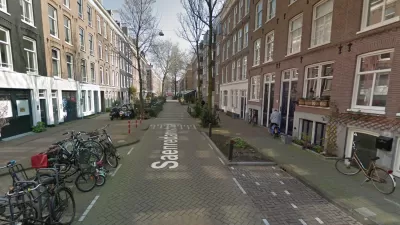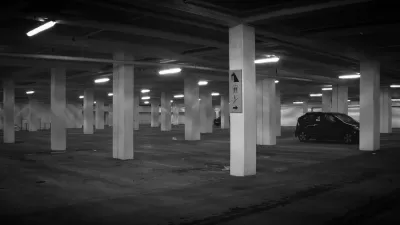As American vehicles grow taller, wider, and longer, more of them are having a hard time fitting in traditional parking spaces.

“Increasingly, cars are too big for parking spaces, especially in parking garages and other paid parking lots where developers pay close attention to space size,” writes Aaron Gordon in Vice. “Like the proverbial frog in a slowly heating pot of water, our cars have gotten ever-so-gradually bigger with each passing year, but the parking space standards have barely budged.”
Gordon describes the process by which parking lot designers decide space sizes, which uses the 85th percentile car size. “This approach to designing parking spaces has historically served the parking industry well, ensuring space sizes accommodate the vast majority of American cars and leaving about 20 inches of space for people to open their doors and maneuver on either side.”
But now, “the 85th percentile method is not capturing the changes in the car sizes. The size of the 10th percentile car has exploded. The size of the 50th percentile car has grown tremendously. The size of the 70th percentile car has also grown. But the 85th percentile car is essentially the Ford F-150, which is much taller and longer than it used to be, but no wider.”
With parking spaces costing thousands or even tens of thousands of dollars each to build, even a few inches can make a significant difference in a project’s budget. To build larger spaces, developers will have to raise the cost of parking for everyone—or just for larger cars, like some parking lots in cities like New York already do. “It’s easy to imagine the backlash that may ensue from any effort to charge people with large vehicles more for parking, even though the suggestion that people who use more of something should pay more than people who use less is one of the most basic tenets of economic theory and the basis of capitalism.” But larger cars don't just take up more space—they pose increased safety risks, too.
FULL STORY: American Cars Are Getting Too Big For Parking Spaces

Study: Maui’s Plan to Convert Vacation Rentals to Long-Term Housing Could Cause Nearly $1 Billion Economic Loss
The plan would reduce visitor accommodation by 25,% resulting in 1,900 jobs lost.

North Texas Transit Leaders Tout Benefits of TOD for Growing Region
At a summit focused on transit-oriented development, policymakers discussed how North Texas’ expanded light rail system can serve as a tool for economic growth.

Why Should We Subsidize Public Transportation?
Many public transit agencies face financial stress due to rising costs, declining fare revenue, and declining subsidies. Transit advocates must provide a strong business case for increasing public transit funding.

A Visual Celebration of Manhattan’s Chinatown Elder Community, Through Food
Lanterns, cafeteria trays, and community connection take center stage in this stunning photo essay.

How to Make US Trains Faster
Changes to boarding platforms and a switch to electric trains could improve U.S. passenger rail service without the added cost of high-speed rail.

Columbia’s Revitalized ‘Loop’ Is a Hub for Local Entrepreneurs
A focus on small businesses is helping a commercial corridor in Columbia, Missouri thrive.
Urban Design for Planners 1: Software Tools
This six-course series explores essential urban design concepts using open source software and equips planners with the tools they need to participate fully in the urban design process.
Planning for Universal Design
Learn the tools for implementing Universal Design in planning regulations.
City of Santa Clarita
Ascent Environmental
Institute for Housing and Urban Development Studies (IHS)
City of Grandview
Harvard GSD Executive Education
Toledo-Lucas County Plan Commissions
Salt Lake City
NYU Wagner Graduate School of Public Service





























